#Ischigualasto formation
Explore tagged Tumblr posts
Text

And here the result from yesterdays Ischigualasto formation #paleostream! This formation is famously known as the "cradle of dinosaurs", with animals like Eoraptor and Herrerasaurus. Which meant we went of course for the Hyperodapedon-Exaeretodon-Herrerasaurus biozone.

Until a few days ago I had no idea what scenario to go for but while scribbling in the spring sun I came across this composition idea with the hollow tree in the foreground. It was further inspired by the plant taphonomy from this formation which sometimes records flooding events

This part of the formation preserves a semiarid floodplain that was seasonally influecned by the Pangean monsoon cycles. The environment has been compared to modern day temperate grasslands but with the absence of grass this environment probably looked more like an open woodland.

The size chart was, once again, put together by Discord member JW but a shout out also goes to Mauricio Garcia (Maurissauro) who produced many of the skeletal drawings in this chart!
#paleoart#sciart#paleostream#palaeoblr#ischigualasto formation#triassic#dinosaur#dinosaurs#eoraptor#saurosuchus
223 notes
·
View notes
Text


Proterochampsa (2025 version)
Vector illustration, 2022-2025.
#paleoart#illustration#vector#argentina#triassic#ischigualasto formation#proterochampsa#archosauriformes
19 notes
·
View notes
Text
Archovember 2024 Day 24 - Sillosuchus longicervix

As we know by now, pseudosuchians ruled the earth during the Triassic period, slotting into many different niches and utilizing many different body shapes than just the semi-aquatic crocodilians we have today. Poposauroids especially filled many of the niches dinosaurs would later come to fill, and even resembled them. Our previously visited Lotosaurus was convergent with hadrosaurs and stegosaurs. Poposaurus was convergent with theropod carnivores. The shuvosaurids resembled ornithomimid theropods, and one shuvosaurid in particular: Sillosuchus longicervix, reached sizes that would make the early sauropodomorphs tremble.

Sillosuchus lived in Late Triassic Argentina. The holotype, while still quite large for a shuvosaurid, was about 3 m (9.8 ft) long. But then, a finding of a large Sillosuchus-like neck vertebrae, as well as fragments of the tibia and ankle, pushed this animal’s size estimates up to 9 to 10 m (30 to 33 ft) in length, making it the tallest terrestrial pseudosuchian known. It would have had a beak like its relatives Effigia and Shuvosaurus, and likely used it to shear off plant material, reaching higher into the trees than any pseudosuchian would have ever hoped to dream. And since Sillosuchus came first, this makes sauropods the copy-cats!

Sillosuchus was found in the Cancha de Bocha member of the Ischigualasto Formation, which was at the time characterized by a dry climate with meandering rivers and seasonal rainfall. Sillosuchus would have lived alongside other dinosaur-like pseudosuchians, including the armoured Aetosauroides, the small, agile Trialestes, and the apex predator Saurosuchus. Dinosaurs would have included the early sauropodomorphs Chromogisaurus, Panphagia, and Eoraptor, and the early theropods Eodromaeus, Sanjuansaurus, and Herrerasaurus. Other reptiles would have included the silesaur Ignotosaurusm, the mysterious Incertovenator, the crocodile-like Proterochampsa and Pseudochampsa, the bizarre rhyncosaur Hyperodapedon, and the lepidosauromorph Taytalura. Synapsids like cynodonts and dicynodonts were also common here, and temnospondyls lived within the meandering rivers.
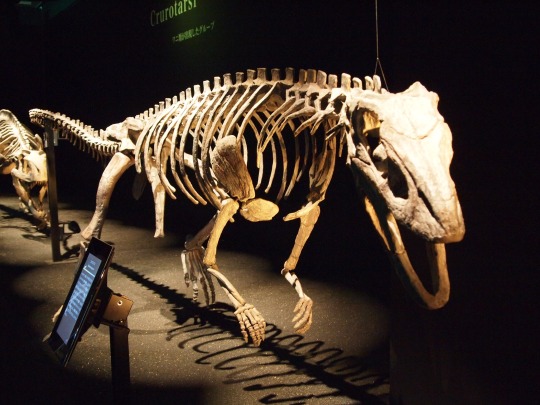
This art may be used for educational purposes, with credit, but please contact me first for permission before using my art. I would like to know where and how it is being used. If you don’t have something to add that was not already addressed in this caption, please do not repost this art. Thank you!
#Sillosuchus longicervix#Sillosuchus#poposaur#poposaurids#pseudosuchians#archosaurs#archosauromorphs#reptiles#Archovember#Archovember2024#Dinovember#Dinovember2024#SaritaDrawsPalaeo#Late Triassic#Argentina#Ischigualasto Formation
24 notes
·
View notes
Text
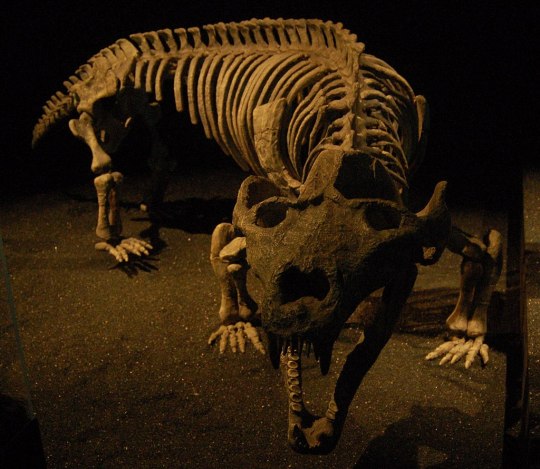
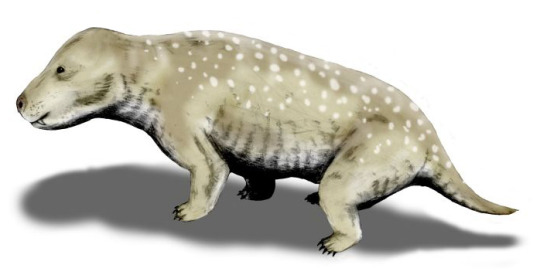

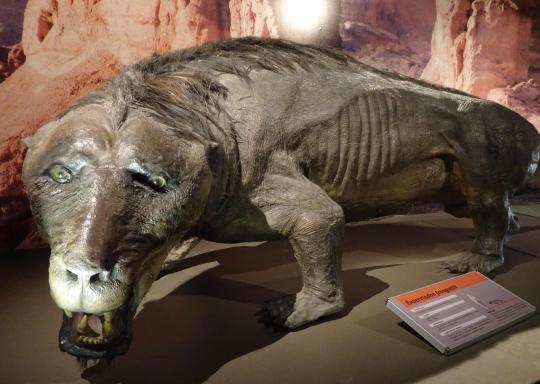
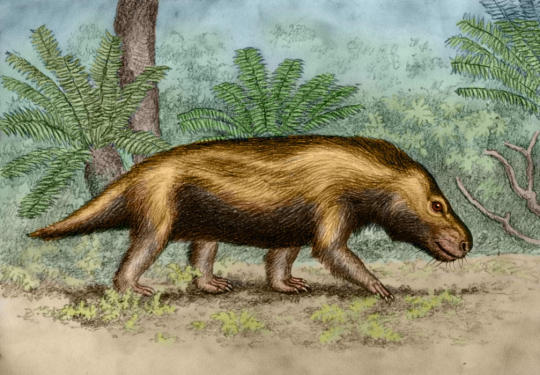
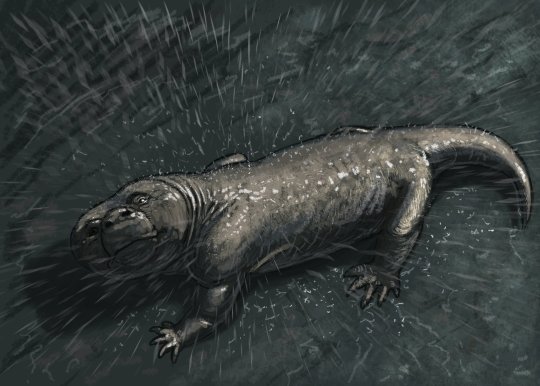
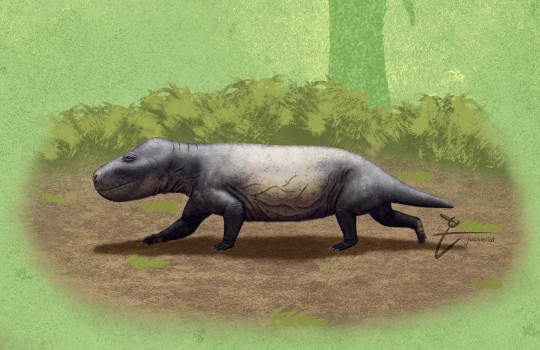

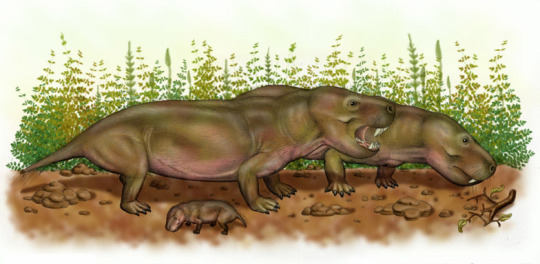
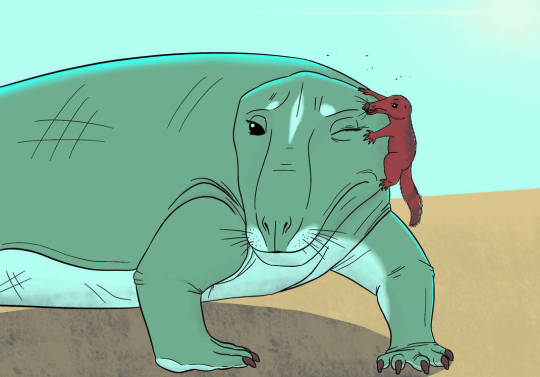
Exaeretodon is an extinct genus of traversodontid cynodont which lived throughout what is now India and South America from the Ladinian stage to the Norian stage of the Triassic period some 235 to 205 million years ago. The naming of exaeretodon seems to have a bit of a complicated history with different specimens having been attributed to various genere such as Belesodon, Traversodon, Theropsis, Ischignathus with the later two genere now considered completely synoyomous with exarertodon. For example the type specimen consisting of a near complete skull was initially described as Belesodon argentines in Ángel Cabrera until with the help of José Bonaparte, they distinquished it as its own distinct genus. Today over 200 specimens have been recovered, some in remarkably good condition including a mother who was preserved pregnant with two calves. Four species are considered valid. E. argentinus from the the Ischigualasto Formation in the Ischigualasto-Villa Unión Basin of northwestern Argentina. E. major and E. riograndensis are from the Santa Maria Formation of the Paraná Basin in southeastern Brazil. And E. statisticae is from the Lower Maleri Formation of India. Reachign some 5 to 6ft (1.5 to 1.8m) in length and 130 to 190lbs (60 to 86kgs) in weight, exaeretodon was a fairly large low-slung creature. Despite its massive jaws and terrifying appearance, studies show its teeth were well developed to grind vegetation meaning that exaeretodon was likely a grazing herbivore. And was on of the most numerous herbivores of the middle and late Triassic southern pangea.
Art used can be found at links below
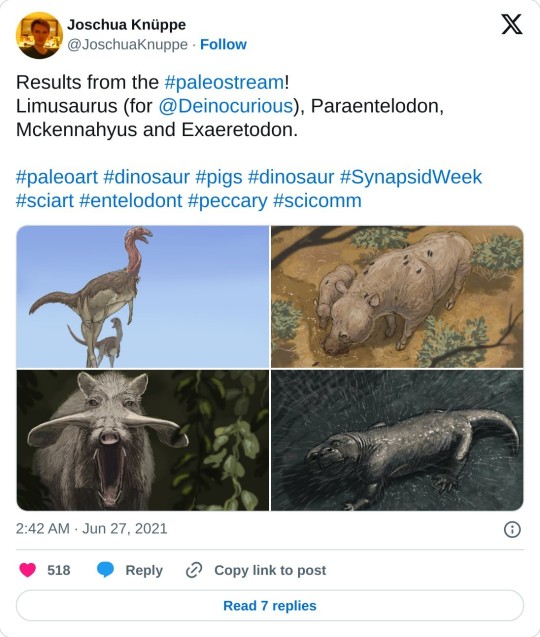
9 notes
·
View notes
Text
Moon Valley, Ischigualasto Provincial Park, Argentina: Ischigualasto Provincial Park also called Valle de la Luna (Valley of the Moon), due to its moon-like appearance, is a provincial protected area in the north-east of San Juan Province, north-western Argentina, limiting to the north with the Talampaya National Park, in La Rioja Province. Both areas belong to the same geological formation, the Ischigualasto Formatio. Established on 3 November 1971, the park has an area of 60,370 ha.In 2000, UNESCO included Ischigualasto and Talampaya National Park among its World Heritage Sites. Wikipedia
#Valley of the Moon#Moon Valley#Parque Provincial Ischigualasto#Ischigualasto Provincial Park#Nearest city San José de Jáchal#San Juan Province#Argentina#South America#South America continents
95 notes
·
View notes
Text
picking these 10 was very difficult there are too many triassic weirdos and I'm not even touching the sea right now
125 notes
·
View notes
Note
top 5 places in argentina? like, places you'd recommend to foreigners visiting your country? especially if they're not particularly famous
(hope that's not too intrusive for you, it's alright if you're not comfortable answering!)
what a great question, thank you! (it probably will end up being popular places, but let's be honest, they're popular for a reason and i want everyone to know about them!)
bariloche - i think the south of argentina is possibly the most beautiful spot on earth, and i absolutely adore bariloche. yes, there are other towns that are probably prettier (san martín de los andes, villa la angostura, all worthy of a visit), but i've been lucky enough to go to bariloche many times thanks to a friend with family there, so it's very special to me. some of the most spectacular vistas everywhere, lots of trekking to do, sailing excursions, and even action adventures las rafting and the like, it's such a perfect place for me (bonus for my most favorite place there, the tea house bellevue, obligatory stop there!). i've only really visited during summer (except for that one time with the school graduation trip, of course), but i'd love to see it in winter, it must be gorgeous!
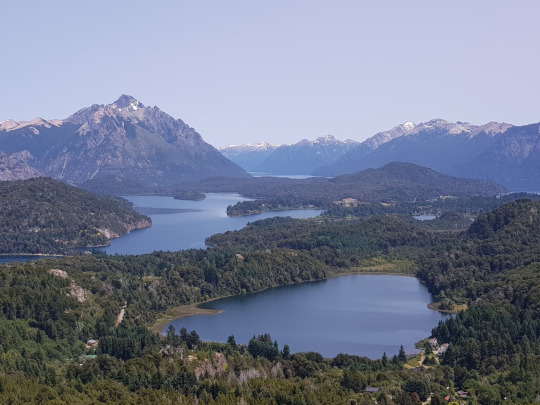
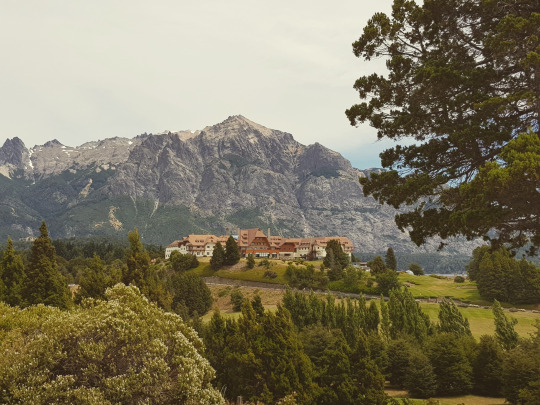

(here are some pics of mine, this last one is the view from bellevue, it's so dreamy!)
glaciar perito moreno - ok, while we're still in patagonia, i might as well mention the perito moreno glacier, cause it's honestly jawdropping. to be there, in silence, looking at that massive wall of ice, it's humbling and awe-inspiring, i don't know how else to put it. and if you're lucky enough to see the ice breaking and falling, i can't imagine how that would feel like. of course, global warming is definitely troubling when it comes to natural wonders like this, but man, it's simply incredible. i've heard there are excursions to walk on the ice as well, that's a bit scary to me, but it must be one hell of an experience.
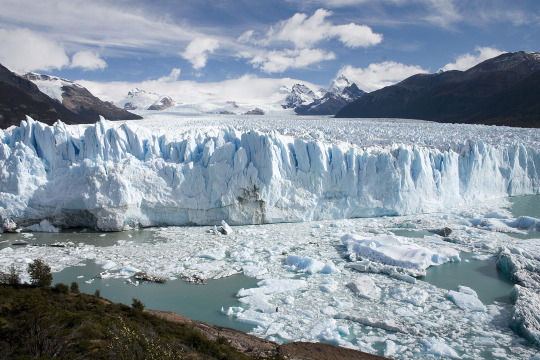
valle de la luna and talampaya - two national parks (the first one literally called "valley of the moon", but its real name is national park ischigualasto) they are...something else. the valle de la luna is possibly the most otherwordly place i've ever seen. it's this vastness of rock carved by the wind, the sun, the water for millions of years, truly looking like an alien landscape. you can literally see the evolution of the earth in its geological formations, and it's also really important for paleontological research. talampaya is right next door and it's breathtaking as well, reddish and strange and wonderful (first pics are the valley of the moon, the other two talampaya).
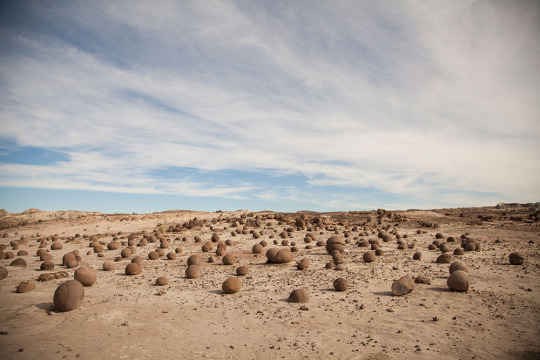


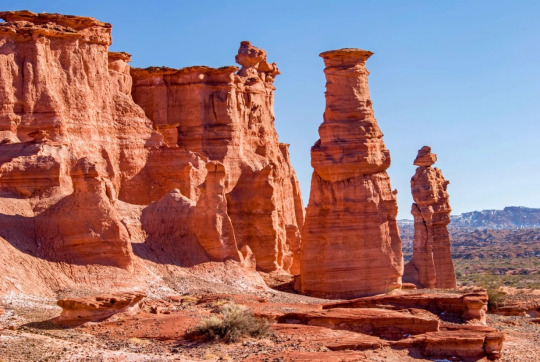
cataratas del iguazú - probably the most famous one (natural wonder of the world!) but like, for a goddamned reason! absolutely insane experience that i'd love to relive someday because i was very young when i went there. but yeah, standing there and seeing the intense, beautiful, dangerous force of nature that is those immense waterfalls, it's crazy. i mean, one of the sections of the waterfall is called garganta del diablo, devil's throat, so yeah, this shit is POWERFUL. i'd loveee to do one of those crazy boat trips that get close to the waterfalls, that seems insane lmao. also i think they did night trips to the garganta del diablo? that must be a religious experience!
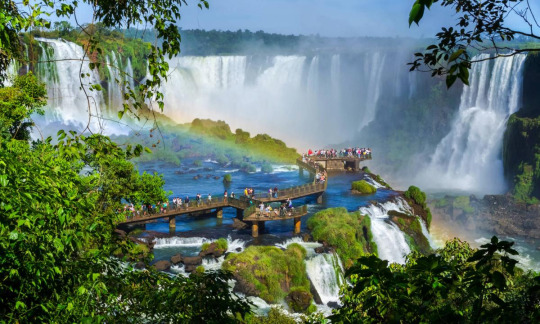

ciudad de buenos aires - i mean of courseeee i'm gonna say buenos airessss that is my PLACE. and sure, you know how a lot of the times natives end up knowing a lot less about their city than the tourists that come visit? yeah, i'm probably not the best guide, but i could show you the places that TRULY matter, like the botanical gardes that i love to chill in, and the street i love to walk on especially when the jacarandá trees are in bloom, or the cemetery that we all love, or that vegan place with kinda mid food but a really cool, funky atmosphere, or that escape room i've been meaning to go to. what i'm trying to say is that buenos aires is my place in the world, and i could never, ever leave here. i carry it in my bones and in my blood (and for the argentines reading this, Y SI, puta...y porteña <3). no professional, touristy pics here, just some random shit from my camera roll.

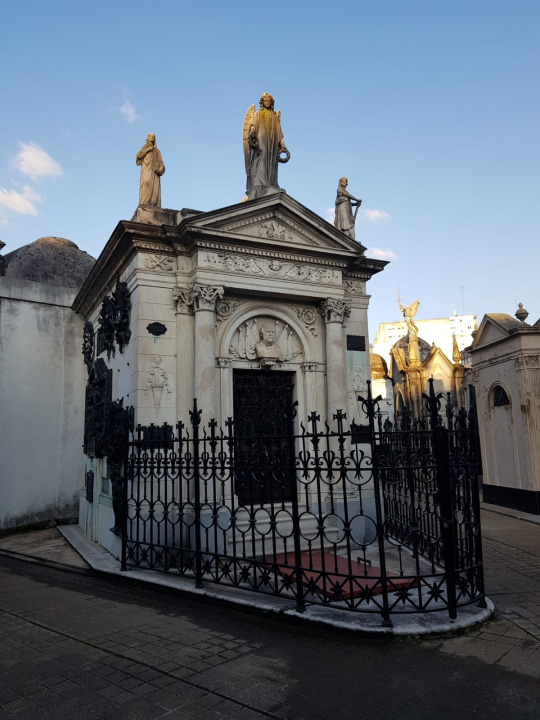
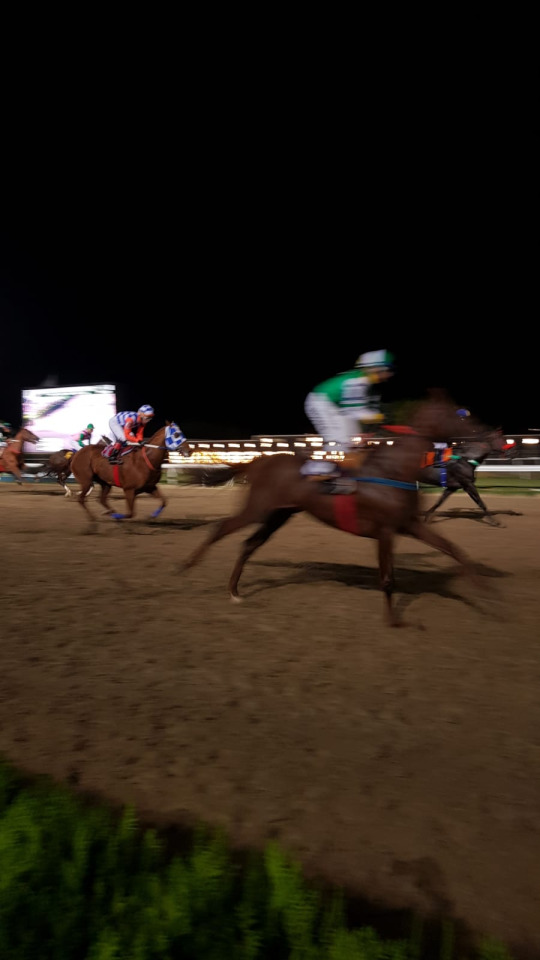



#argentina#juli answers#ask game#oh wow this got a bit long but i couldn't help myself#thanks for the opportunity to shout out my beautiful diverse country!#and still so many places that i didn't mention (and many that i need to visit as well!)#(that bottom middle pic from bs as is from when we won the world cup dont worry it's not like that every day lmao....OR IS IT)
11 notes
·
View notes
Text

Valley of the Moon, Argentina
Ischigualasto Provincial Park, also called Valle de la Luna (“Valley of the Moon” or “Moon Valley”), due to its otherworldly appearance, is a provincial protected area in the north-east of San Juan Province, north-western Argentina, limiting to the north with the Talampaya National Park, in La Rioja Province.
Both areas belong to the same geological formation, the Ischigualasto Formation (sometimes Ischigualasto-Talampaya Formation) Established on 3 November 1971, the park has an area of 60,370 ha (603.7 km2; 233.1 sq mi)
Side Note: Here's something else the eco freaks can spray paint. In life you are either a creator or a destroyer. Enviro-whackos are nothing but destroyers.
4 notes
·
View notes
Text
Answer time! For a very long time, Eoraptor and Herrerasaurus were considered the oldest dinosaurs. They come from the Ischigualasto Formation in Argentina.

However, Nyasasaurus of Tanzania possibly comes from middle Triassic rocks which makes it older than these two.

Now, if you agree with research release this year, even Nyasasaurus might not be the oldest. It might be the silesaurid, Gamatavus who definitely comes from middle Triassic Brazilian rocks. Silesaurids were long thought to be a sister taxa to dinosaurs but very recent wok shows they might actually be early ornithischian dinosaurs. How cool is that?

However you look at it, all of these are very old avemetatarsalians!
Trivia Tuesday
16 notes
·
View notes
Text
Dinofact #69
Dinovember day 2: Herrerasaurus
All known specimens of Herrerasaurus were found in the Ischigualasto Formation of northwestern Argentina, which dates back to the late Triassic period. Herrerasaurus is one of the earliest known dinosaurs in the fossil record.
Source: Wikipedia
#dinosaur#dinosaurs#dinovember#dinovember 2022#dinovember2022#paleontology#herrerasaurus#argentina#Ischigualasto#Ischigualasto Formation#triassic#triassic period#late triassic#late triassic period#carnian#carnian age#fun facts#trivia#dinosaur trivia#dinosaur fun facts#2nd#november#2022#november 2nd#november 2022#november 2nd 2022
15 notes
·
View notes
Note
What's the earliest known *definitive* dinosaur?
Currently, that would be Staurikosaurus!

Staurikosauus is from the Lower Santa Maria Formation, and has been dated to 233.23 million years old, making in about 1.5 million years older than other very early dinosaurs like Eoraptor and Herrerasaurus from the Ischigualasto Formation!
However, if we want to delve into questionable dinosaurs, there's a genus named Nyasasaurus that is known from very fragmentary remains, and may or may not be a dinosaur!
Nyasasaurus is from the Manda Formation in Tanzania, which seems to have been roughly 235-240 million years old, although dating is a bit shaky with this one. If Nyasasaurus is really a dinosaur it would be the oldest known, but again we don't have enough of the skeleton to be sure! The Wikipedia reconstruction of it literally looks like this, to give you an idea of how uncertain its anatomy is:
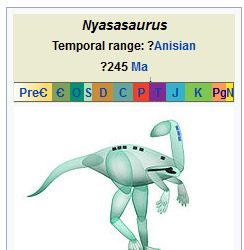
#dinosaurs#paleontology#paleoart#my art#staurikosaurus#nyasasaurus#early dinosaurs#fossils#prehisoric#palaeoblr
357 notes
·
View notes
Text
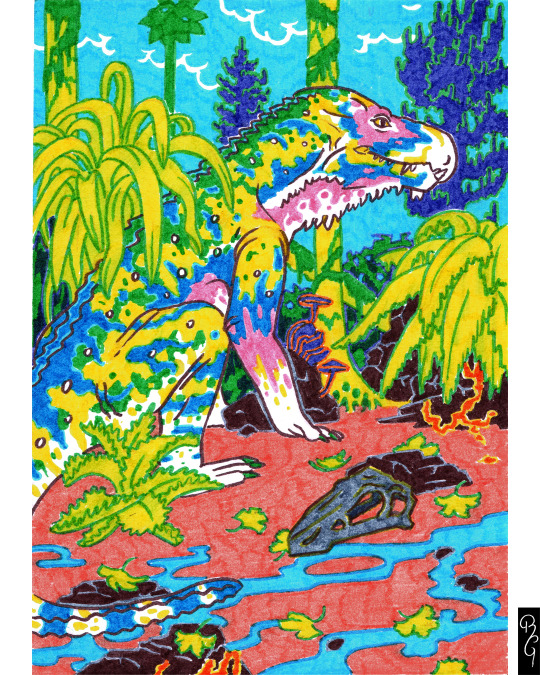
Ischigualasto series, alternate takes:
Venaticosuchus, fiber pen, 2023
#paleoart#triassic#illustration#ischigualasto formation#archosauria#pseudosuchia#ornithosuchidae#venaticosuchus#fiber pen#fiber#abstract paleoart
196 notes
·
View notes
Text

Adding the Ischigualasto formation from the Upper Triassic of Argentina, known for some of the oldest dinosaurs.
We are approaching the maximum of images you can post here so I thought it was time I make a little showcase of all the formation pieces we covered so far on the streams.





























For people who don't know: for several months now I draw one formation or fossil locality every Saturday. The next place we visit is chosen by a wheel of names, which we also constantly fill up again when a new formation is picked.
I try to make it as interesting as possible in my composition and choice of animals and I can tell you this series has been a great training when it comes to constructing these, how I call them, Menageries.
I have to thank a team of friends and colleagues who help behind the scenes with research, creation of size charts and conversation partners when it comes to deciding on the compositions of these pieces. Their help has been invaluable!
12K notes
·
View notes
Text
Walking in the Ischigualasto Formation
"Walking in the Ischigualasto Formation" a Argentinian cowgirl beholds the amazing fauna of the Triassic Period.

View On WordPress
#adobe photoshop#argentina#artistatwork#Commissions Open#Cowgirl#Digital Art#DigitalPainting#dinosaurs#early mammals#early reptiles#Environment Art#Environment Design#environmental art#herbivores#paleontology#Palo Art#Triassic Period#Wacom Tablet
13 notes
·
View notes
Text
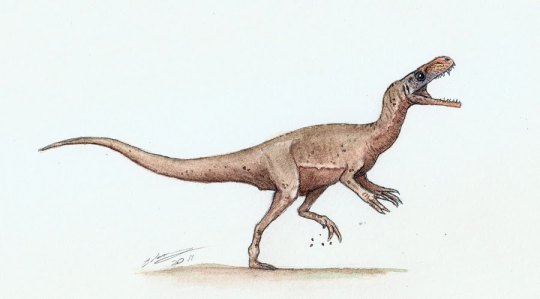
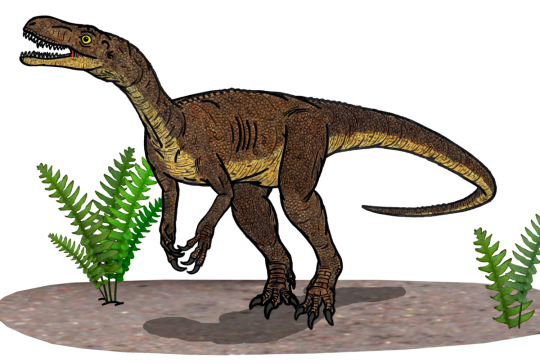
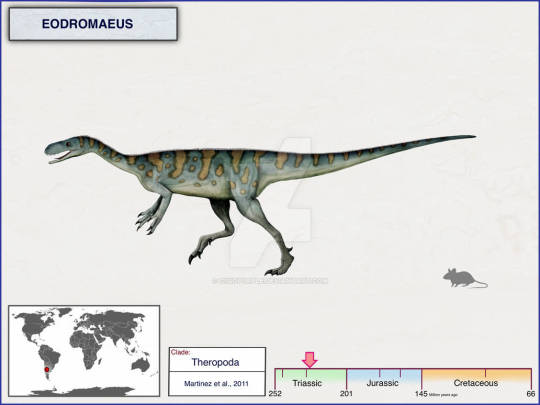
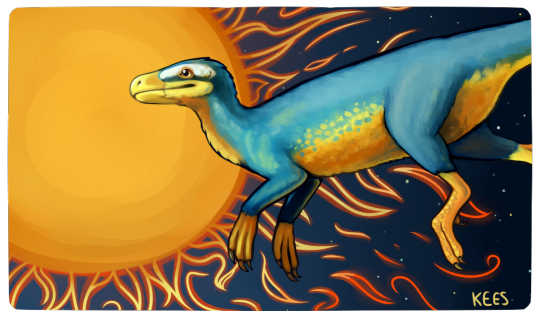
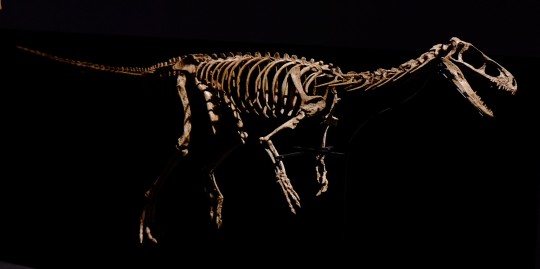

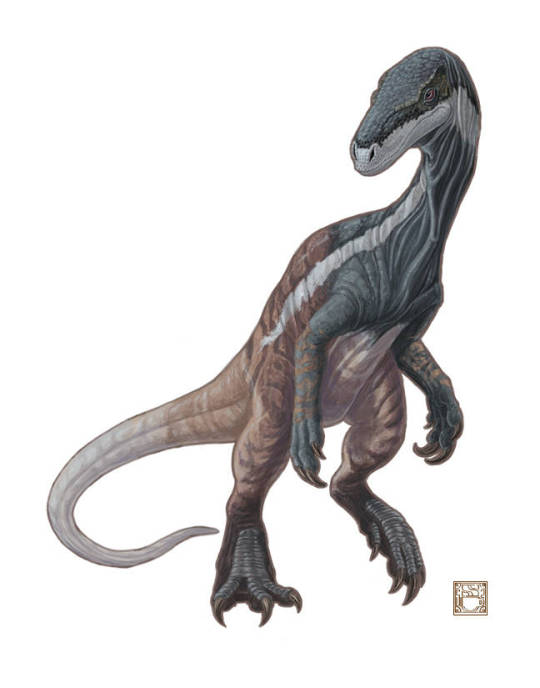
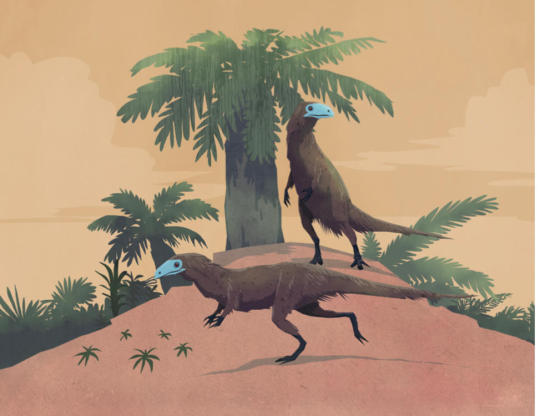
Eodromaeus is an extinct genus of probable basal theropod dinosaur which lived throughout what is now South America during the Carnian stage of the Triassic period some 232 to 228 mya. The first remains now known to be eodromaeus was a crushed but nearly complete articulated skeleton was recovered from the base of the Valle de la Luna Member of the Ischigualasto Formation by Argentinean paleontologist Ricardo N. Martinez and Earthwatch volunteer Jim Murphy in 1996. However both believed it to be a new species of eoraptor. It wouldn’t be until 2011 that an indepth review of the specimens would recognize that they warrented being classified as there own genus which was dubbed Eodromaeus meaning dawn runner in greek. With the specific name murphi honoring Jim Murphy. Today the remains of at least six eodromaeus specimens are known. Reaching around 3.9ft (1.2m) in length and 9.9 to 16lbs (4.5 to 7.1kgs) in weight, Eodromaeus was a small and lightly built dinosaur which had long hindlimbs making it well built for running. It had a low rectangular skull with slender lower jaw and a deep brain case. When originally described in 2011, Eodromaeus was regarded as the earliest member of Theropoda. This has been continousely supported by many subsequent studies; however there has been some that argue that Eodromaeus is rather a basal saurischian and possibly ancestral to theropods as a whole. What is known is that this small carnivorous dinosaur lived alongside and occasionally fed upon a variety of the strange and wondrous Triassic weirdos that called the Ischigualasto formation home.
art used can be found at the following links
#pleistocene pride#pliestocene pride#mesozoic#triassic#eodromaeus#theropod#dinosaur#ischigualasto formation
2 notes
·
View notes
Text
Chiniquodon
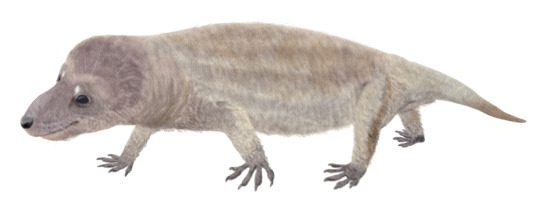
(Image: Chiniquodon, a medium-sized, rather generic-looking protomammal with a short tail, depicted here with a covering of short hair. Image by @Stolpergeist)
Etymology: Tooth from Chiniquá, Brazil
First described by: von Huene, 1936
Classification: Biota, Archaea, Proteoarchaeota, Asgardarchaeota, Eukaryota, Neokaryota, Scotokaryota Opimoda, Podiata, Amorphea, Obazoa, Opisthokonta, Holozoa, Filozoa, Choanozoa, Animalia, Eumetazoa, Parahoxozoa, Bilateria, Nephrozoa, Deuterostomia, Chordata, Olfactores, Vertebrata, Craniata, Gnathostomata, Eugnathostomata, Osteichthyes, Sarcopterygii, Rhipidistia, Tetrapodomorpha, Eotetrapodiformes, Elpistostegalia, Stegocephalia, Tetrapoda, Reptiliomorpha, Amniota, Synapsida, Eupelycosauria, Sphenacodontia, Sphenacodontoidea, Therapsida, Eutherapsida, Neotherapsida, Theriodontia, Eutheriodontia, Cynodontia, Probainognathia, Chiniquodontoidea, Chiniquodontidae
Referred Species: C. theotonicus, C. brasilensis, C. kalanoro, C. sanjuanensis
Status: Extinct (sadly :( )
Time and place: Chiniquodon lived from the Ladinian to the Carnian of South America and Africa (including Madagascar), about 242-227 million years ago.


Physical Description: As a cynodont, Chiniquodon was a close relative of mammals, but it’s aberrant compared to most fossil mammal relatives in one key respect: It’s known from more than just teeth! You heard that right, Chiniquodon is known from several reasonably complete skulls, as well as some body fossils. Thus, we can actually have some discussion of its appearance and anatomy beyond the teeth!
Chiniquodon was a medium to large (for the time) cynodont, with a skull length up to 33cm/13in in length. This skull had wide zygomatic arches (attachment points for jaw muscles!), and a solid secondary palate (as in modern mammals).
Its limbs and hips show that it was adapted to walk with its legs directly under the body, as in modern mammals. It had a fairly short tail. While we don’t have any direct evidence of its body covering, it’s likely that it had some hair, as has been inferred in other cynodonts. It got up to about the size of a medium dog.
…..But let’s be real, this is a mammal relative. We have to talk about teeth at some point.
Luckily for us, Chiniquodon has interesting teeth! Like, really interesting. Here’s a diagram of the skull of a typical chiniquodont:

(Image: A diagram of the skull of a typical chiquodont. It’s got very large canines. Illustration B shows its cheek teeth from the side (top) and from the top (bottom). Image from Abdala and Giannini, 2002.)
What is the significance of these teeth? I guess you’ll have to wait until the “diet” section to find that out!
Diet: Oh look, we’re here. What were we on? Oh, right! The significance of these teeth. I’m sure many of you are chomping at the bit to find out what they were eating, and are about to point to those huge canines as proof that they were ravenous carnivorous beasts. And you may be on the cusp of an incisive argument, but I’d like to remind you that large canines do not a carnivore make, and modern musk deer have large canines themselves. To truly understand what an animal is eating, we need to look at the teeth that we know it used to process food. In this case, those are the cheek teeth.
The cheek teeth of Chiniquodon are a particular shape of tooth called a carnassial. That carn- is the same carn- as in carnivore or carnival or chile con carne, and it means meat. That’s because it’s a shape of cheek tooth that is especially good at cutting meat, because they have very large cusps that shear past each other when the animal bites down. Carnassials are found in many modern carnivorans (including dogs and cats!), but the carnassials of Chiniquodon evolved completely independently from those of dogs or cats – an amazing example of convergent evolution.
Behaviour: As a terrestrial carnivore, Chiniquodon must have hunted at some time. It likely hunted small vertebrates, such as other synapsids or young dinosaurs, though it likely wouldn’t have turned down scavenging from a carcass or eating bugs when it was younger. It almost certainly laid eggs, which it may have laid in a burrow. It is not clear whether any parental care was present.
Ecosystem: During the Triassic, all of the continents were combined into one, and this led to a very hot and dry climate over much of the Earth. Chiniquodon’s environment was no exception, and fossils of it are found in rocks interpreted to have been deposited by braided streams in an arid environment. With that said, some fossils of it are also found in rocks distributed during the Carnian Pluvial Event (aka That Time It Rained For Several Thousand Years; no relation to carnassials). These rocks contain the remains of animals like the early dinosaurs Eoraptor and Herrerasaurus, crocodile relatives like Gualosuchus, large dicynodonts like Ischigualastia, and other cynodonts like Probainognathus.
Other: Chiniquodon, in our prehistoric hindsight, is positioned right around one of the most significant transitions in mammalian evolution. It records the condition of cynodonts at a pivotal point, when it and its relatives were only just evolving furry body coverings and specialised jaw joints, and it’s a crucial fossil in untangling how its close close relatives miniaturised, going from medium-sized animals to the tiny shrew-like creatures that became the ancestors of all mammals. Today, with our prehistoric hindsight, Chiniquodon represents a sideshoot off of the mammal line during a pivotal transition time – but in its brightest day, when it was scurrying about the floodplains of South America and Africa, it was merely another animal fighting for existence in the world of the Triassic.
~ By Hayley Orlowski
Sources under the cut
Abdala, F.; Giannini, N. P. (2002). "Chiniquodontid cynodonts: systematic and morphometric considerations". Palaeontology. 45 (6): 1151–1170. doi:10.1111/1475-4983.00280.
Kammerer, C. F., Flynn, J. J., Ranivoharimanana, L., & Wyss, A. R. (2010). The first record of a probainognathian (Cynodontia: Chiniquodontidae) from the Triassic of Madagascar. Journal of Vertebrate Paleontology, 30(6), 1889–1894. doi:10.1080/02724634.2010.520784
Kemp, T. S. (2009). The endocranial cavity of a nonmammalian eucynodont, Chiniquodon theotenicus, and its implications for the origin of the mammalian brain. Journal of Vertebrate Paleontology, 29(4), 1188–1198. doi:10.1671/039.029.0430
Martinez, R. N., & Forster, C. A. (1996). The skull of Probelesodon sanjuanensis, sp. nov., from the Late Triassic Ischigualasto Formation of Argentina. Journal of Vertebrate Paleontology, 16(2), 285–291. doi:10.1080/02724634.1996.10011315
Mocke, H. B. (2016). The postcranium of the carnivorous cynodont Chiniquodon from the Middle Triassic of Namibia and the palaeo-environment of the Upper Omingonde Formation (Masters dissertation).
Oliveira, T. D., Schultz, C. L., & Soares, M. B. (2009). A partial skeleton of Chiniquodon (Cynodontia, Chiniquodontidae) from the Brazilian Middle Triassic. Revista Brasileira de Paleontologia, 12(2), 113-122.
#chiniquodon#chiniquodontian#cynodont#probainognathian#triassic#triassic madness#triassic march madness#prehistoric life#paleontology
257 notes
·
View notes